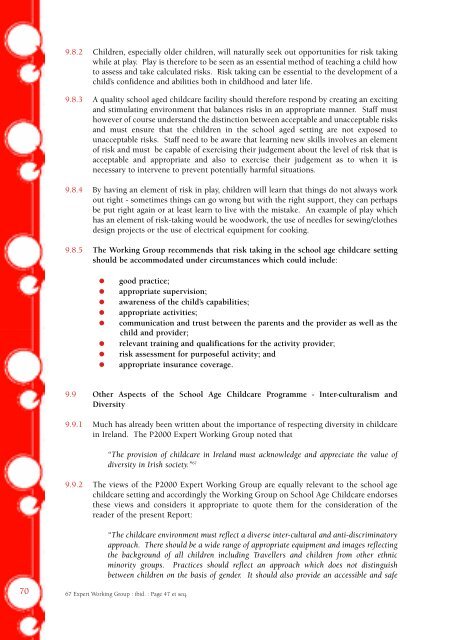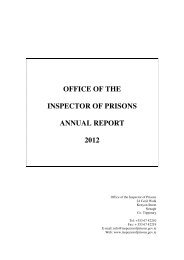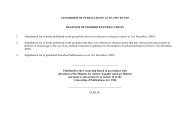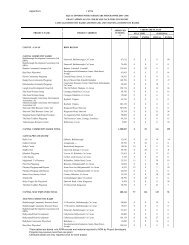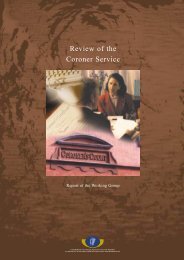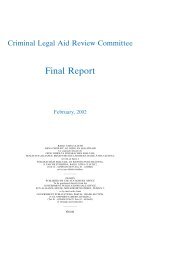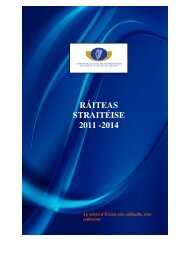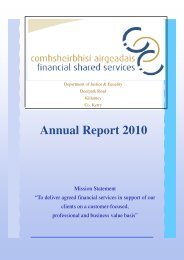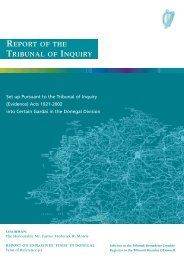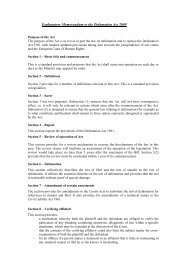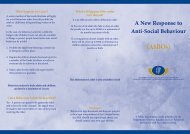Developing School Age Childcare - Department of Children and ...
Developing School Age Childcare - Department of Children and ...
Developing School Age Childcare - Department of Children and ...
You also want an ePaper? Increase the reach of your titles
YUMPU automatically turns print PDFs into web optimized ePapers that Google loves.
9.8.2 <strong>Children</strong>, especially older children, will naturally seek out opportunities for risk takingwhile at play. Play is therefore to be seen as an essential method <strong>of</strong> teaching a child howto assess <strong>and</strong> take calculated risks. Risk taking can be essential to the development <strong>of</strong> achild’s confidence <strong>and</strong> abilities both in childhood <strong>and</strong> later life.9.8.3 A quality school aged childcare facility should therefore respond by creating an exciting<strong>and</strong> stimulating environment that balances risks in an appropriate manner. Staff musthowever <strong>of</strong> course underst<strong>and</strong> the distinction between acceptable <strong>and</strong> unacceptable risks<strong>and</strong> must ensure that the children in the school aged setting are not exposed tounacceptable risks. Staff need to be aware that learning new skills involves an element<strong>of</strong> risk <strong>and</strong> must be capable <strong>of</strong> exercising their judgement about the level <strong>of</strong> risk that isacceptable <strong>and</strong> appropriate <strong>and</strong> also to exercise their judgement as to when it isnecessary to intervene to prevent potentially harmful situations.9.8.4 By having an element <strong>of</strong> risk in play, children will learn that things do not always workout right - sometimes things can go wrong but with the right support, they can perhapsbe put right again or at least learn to live with the mistake. An example <strong>of</strong> play whichhas an element <strong>of</strong> risk-taking would be woodwork, the use <strong>of</strong> needles for sewing/clothesdesign projects or the use <strong>of</strong> electrical equipment for cooking.9.8.5 The Working Group recommends that risk taking in the school age childcare settingshould be accommodated under circumstances which could include:good practice;appropriate supervision;awareness <strong>of</strong> the child’s capabilities;appropriate activities;communication <strong>and</strong> trust between the parents <strong>and</strong> the provider as well as thechild <strong>and</strong> provider;relevant training <strong>and</strong> qualifications for the activity provider;risk assessment for purposeful activity; <strong>and</strong>appropriate insurance coverage.9.9 Other Aspects <strong>of</strong> the <strong>School</strong> <strong>Age</strong> <strong>Childcare</strong> Programme - Inter-culturalism <strong>and</strong>Diversity9.9.1 Much has already been written about the importance <strong>of</strong> respecting diversity in childcarein Irel<strong>and</strong>. The P2000 Expert Working Group noted that“The provision <strong>of</strong> childcare in Irel<strong>and</strong> must acknowledge <strong>and</strong> appreciate the value <strong>of</strong>diversity in Irish society.” 679.9.2 The views <strong>of</strong> the P2000 Expert Working Group are equally relevant to the school agechildcare setting <strong>and</strong> accordingly the Working Group on <strong>School</strong> <strong>Age</strong> <strong>Childcare</strong> endorsesthese views <strong>and</strong> considers it appropriate to quote them for the consideration <strong>of</strong> thereader <strong>of</strong> the present Report:“The childcare environment must reflect a diverse inter-cultural <strong>and</strong> anti-discriminatoryapproach. There should be a wide range <strong>of</strong> appropriate equipment <strong>and</strong> images reflectingthe background <strong>of</strong> all children including Travellers <strong>and</strong> children from other ethnicminority groups. Practices should reflect an approach which does not distinguishbetween children on the basis <strong>of</strong> gender. It should also provide an accessible <strong>and</strong> safe70 67 Expert Working Group : ibid. : Page 47 et seq.


